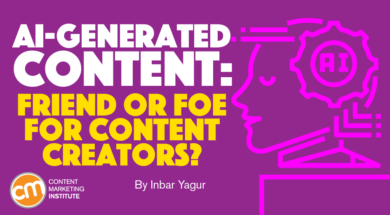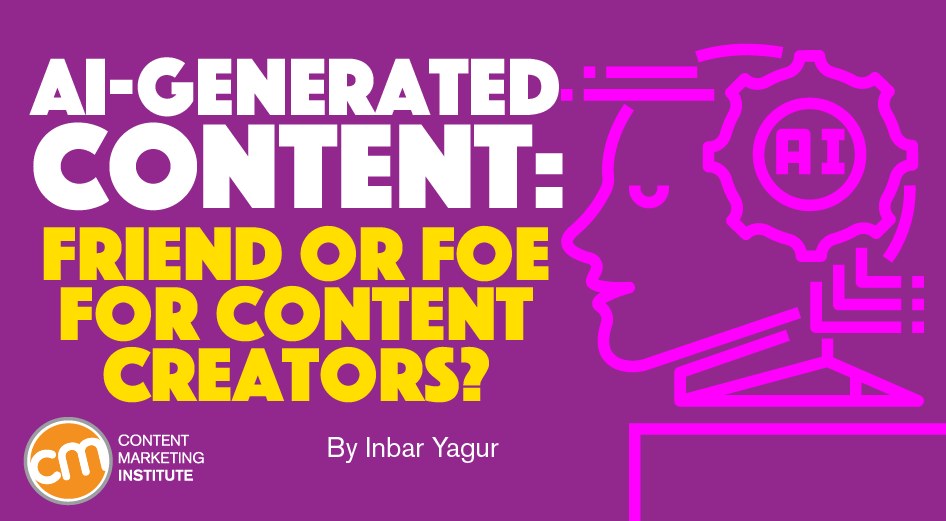 If you had asked me to explain artificial intelligence or AI a few years ago, I probably would have laughed. I’d talk about the Matrix movie trilogy and ponder yet another Terminator sequel.
If you had asked me to explain artificial intelligence or AI a few years ago, I probably would have laughed. I’d talk about the Matrix movie trilogy and ponder yet another Terminator sequel.
Today, I’m ready to talk about AI because I’m a professional writer who now sits in the room with data scientists who work with AI, and I (kinda) understand what they’re saying.
I’m writing this because people keep talking about how AI-generated content is coming for their content marketing job. And that is simply not the case.
Brief history of AI content
Natural-language generation (NLG) has been around since the 1960s. It’s been commercially available for close to 30 years. For most of its history, NLG just wasn’t very good. It couldn’t read well and the text it produced was easily identified as computer-generated.
While it worked for some content that stuck to a formula or cadence, that was it. Later, “content spinners” arrived that rewrote content in hopes other computer-generated readers (i.e., Google search algorithm) would recognize the AI-written text as “new” content. But at the end of the day, they weren’t that good either
A few years ago, new models emerged to alter AI’s success, handling more natural language tasks on par with human creators.
I won’t go into the full semantics. As marketers, we don’t really need to know the nitty gritty – we can leave that to the data scientists. It boils down to this: You no longer need to input a strict set of rules and parameters for AI-creators to produce quality content. The models now require far fewer rules for them to produce quality, and they even can interpret those parameters without human input. That change makes effective AI-created content much more possible for more commercial applications.
You no longer need a strict set of rules and parameters for AI-creators to do quality content, says @content_fairy via @CMIContent. #AI Click To TweetPut simply: The computers learned to read better so now they know how to write better.
These advancements have freaked out a lot of people. But it’s time to come back down to Earth because AI content generation is here to stay, and that’s OK. Hear me out.
AI not as intelligent as you think
Let’s boil down NLG to its most basic level: You give it input. It reads that input and generates output.
To appear as though it was written by a human, someone needs to teach the AI software what “human” looks like and define the right output. It requires hard work and human intervention to work. Think of it this way: AI is a student. People are the teachers.
For example, an AI language model GPT-3 has been lauded, revered, packaged up, and commercialized in the last year or so. Developer and artist Arram Sabeti used it to create some example text and posted it on a blog. “I generally didn’t have work too hard to get it to write amazingly coherent text given a simple prompt,” they write.
And yes, GPT-3 is amazing. It works really well in a lot of applications. But here are some exceptions:
- It’s not very good at writing longer than a few paragraphs.
- It can be hit-or-miss with short-form content. For every good variation, you get one to two duds.
- Manual polish is needed for even the good copy.
Will there be a GPT-4? Probably. Will it be even better? I’d bet on that. But that will continue to be driven by human innovation and intervention.
At face value, AI-generated content would need to test infinite versions of infinite text to find the winners that bring the highest ROI. That would require unlimited time and unlimited budget.
And that, dear human, is where you come in. You are still needed to finesse the right message for your brand voice, your audience, your persona, or your content will get lost in the noise. The real power of AI-generated content is to help find the right language to reach your audience.
The real power of AI-generated content is to help find the right language to reach your audience, says @content_fairy via @CMIContent. #AI Click To TweetAI’s current content impact
I’m a writer. I hate writing.
OK, that’s not 100% true. I hate starting to write. To me, a blank page is a portal to inevitable failure, not to mention a portal to the completion of menial tasks I’ve been ignoring. If you want me to organize that junk drawer, just give me a writing assignment. On the other hand, if I can rework a draft of the content, I fall less on the side of a tortured angsty procrastinator and more on the side of “Hey look at me, I’m a writing machine.”
AI helped me start this article with an outline that looked like this:
Section: What are AI copy generators?
Section: The limitations of AI copy generators
Section: Why people are needed
Section: How businesses are using AI copy generators
Takeaway: Don’t fear AI, embrace it!
AI-generated content assistance has nearly eliminated that dreaded blinking cursor for me. It can:
- Create something I hate and I respond with, “here let me show you how it’s supposed to be done” writing blitz.
- Craft adequate content that I can rework to fit my brand’s needs and voice.
- Give me a starting point in the form or an outline or a blurb.
But there’s more than that. Businesses can use AI-generated content tools to unify communication across departments and channels, such as email subject lines, website copy, ads, etc. Doing it that way can be a big time saver.
Nonprofit Village of the Valley, a client of my employer Anyword, creates a lot of content about what they do and for empowering volunteers. Founder Brandi Powell finds herself having to say the same thing over and over in different ways. AI-generated content helped her find those new ways more easily.
AI-generated #content helped a nonprofit learn how to say the same thing over and over in different ways, says @content_fairy via @CMIContent. #AI Click To TweetSee AI not as a rival, but as a teammate
Not sure if you noticed when typing a Google Doc, but it sometimes gets cheeky and it completes the sentences for you (if you agree by pressing the tab button.) And let’s be honest – it usually finishes your thought correctly. That’s natural-language generation in action, dear human.
Whether you’re using AI-generated content to come up with ideas, say the same thing differently, or craft messages that hit your demographic sweet spot, you’re still doing the creating. You’re still behind the wheel. The cruise control just became a bit more sophisticated.
Cover image by Joseph Kalinowski/Content Marketing Institute

